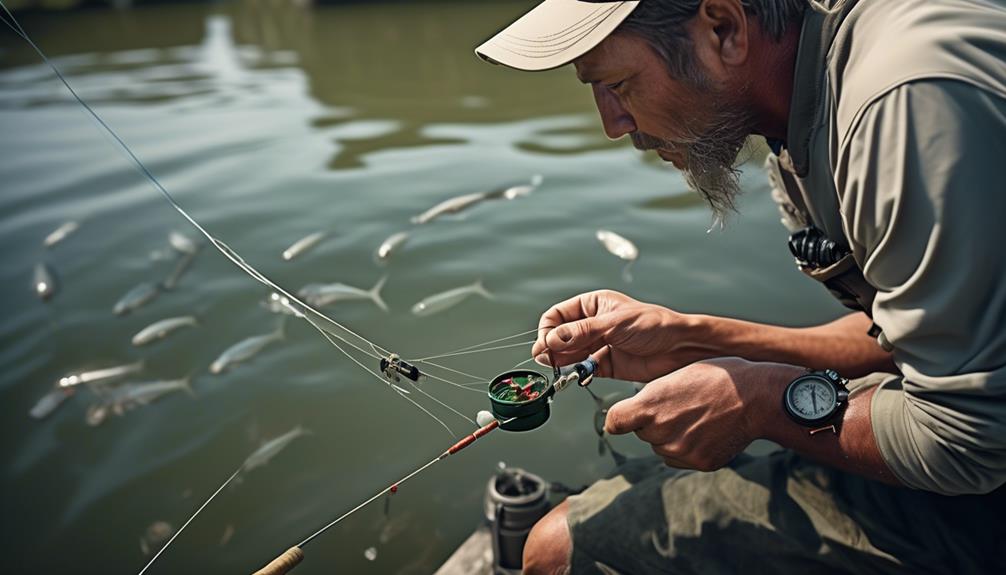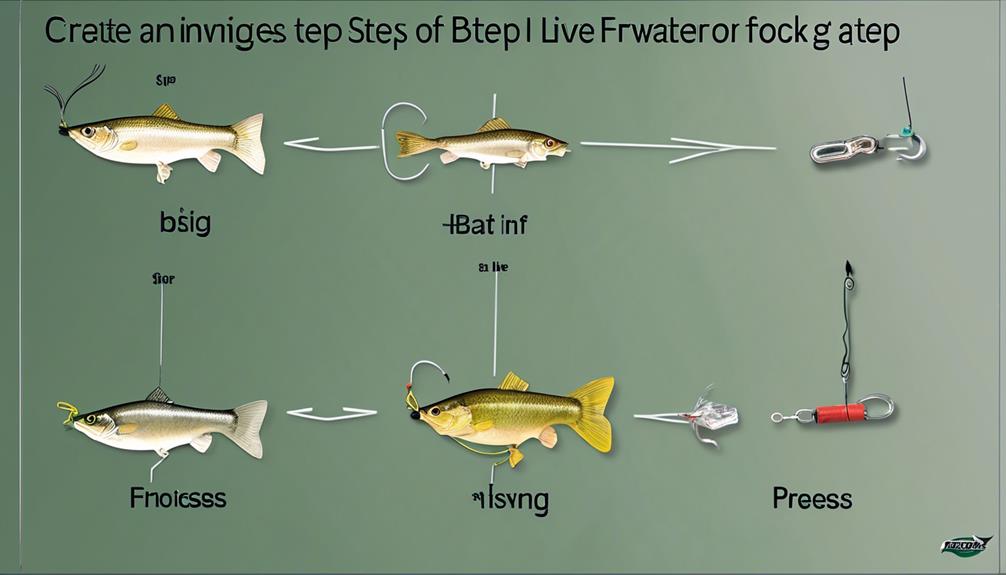When it comes to freshwater fishing, using live bait can increase your chances of catching a trophy fish by up to 50%. Rigging live bait may seem like a straightforward process, but there are 14 essential steps that can make all the difference between a successful fishing trip and coming home empty-handed.
From selecting the right bait to monitoring the bait once it's in the water, each step is crucial for enticing those elusive big bites. So, if you want to maximize your chances of landing the biggest fish in the lake, it's essential to master the art of rigging live baits.
Selecting the Right Bait
What type of bait will attract the specific fish species you're targeting on your next fishing trip? Bait selection is crucial in freshwater fishing. The right bait can make the difference between a successful catch and going home empty-handed. Understanding the behavior and preferences of the fish species you're targeting is essential when it comes to choosing the most effective bait.
When it comes to bait selection, consider the natural prey of the fish you're trying to catch. For example, if you're targeting bass, live bait such as minnows, shad, or worms can be highly effective. On the other hand, if you prefer artificial lures, choosing ones that mimic the movement and appearance of the fish's natural prey can also yield great results.
Fishing techniques also play a significant role in bait selection. For instance, if you're using live bait, the way you rig it can determine how enticing it's to the fish. Properly presenting the bait using the right rigging techniques can significantly increase your chances of a successful catch. Additionally, understanding the behavior of the fish in the specific water body you're fishing in can help you determine the most effective fishing techniques to use with your chosen bait.
Ultimately, successful bait selection in freshwater fishing requires a combination of knowledge about the fish species you're targeting and the right fishing techniques. By understanding these elements, you can increase your chances of a rewarding and successful fishing trip.
Preparing the Hook
To prepare the hook for rigging live bait in freshwater fishing, ensure its sharpness and integrity are optimal for effectively hooking and securing your chosen bait. Begin by checking the hook's sharpness. If it's not sharp enough, use a hook sharpener to hone the point. A sharp hook increases the chances of a successful hookset, ensuring that the fish stays on the line once it bites.
After checking the sharpness, inspect the hook for any signs of damage or rust. A damaged or rusted hook can compromise its strength and durability, increasing the risk of losing a catch. If the hook is damaged or rusted, replace it with a new one to maintain its integrity.
Once the hook is sharp and in good condition, it's time to tie the appropriate knot for securing the live bait. The type of knot used can impact bait presentation and the hook's ability to secure the bait during casting and retrieval. The improved clinch knot is a popular choice for attaching the hook to the line, providing a secure connection that allows for natural bait movement.
Proper knot tying is crucial for ensuring that the bait remains securely attached to the hook, enhancing its lifelike presentation in the water.
Attaching the Bait to the Hook
You typically attach the live bait to the hook by threading it through the designated entry points in a manner that ensures natural movement and presentation in the water. This step is crucial in ensuring that your bait appears as lifelike as possible, increasing its effectiveness in attracting fish. Here's how to properly attach the bait to the hook:
- Bait Selection: It's important to consider the type of bait you're using when attaching it to the hook. For smaller live baits such as minnows or worms, you can thread the hook through the bait multiple times to secure it properly. For larger baits like shiners or crawfish, you may only need to thread the hook through once to maintain their natural movement.
- Hook Preparation: Before attaching the live bait, ensure that the hook is appropriately prepared. This may involve setting the hook size according to the bait being used and making sure that the hook is sharp enough to penetrate the fish's mouth easily. A sharp hook is essential for a successful hookup when a fish strikes.
- Securing the Bait: Once you've selected the appropriate bait and prepared the hook, carefully thread the hook through the bait's entry points. Ensure that the bait is securely attached to the hook to prevent it from falling off during casting or while in the water. Additionally, make sure the bait can move freely to mimic natural swimming or wriggling motions.
Setting Up the Bobber
Positioning the bobber correctly is crucial for effectively presenting your live bait and detecting fish bites. When using slip bobbers, adjusting the depth at which your bait is presented can be easily achieved. Slip bobbers allow you to change the depth of your bait without having to re-tie your rig, making them incredibly versatile for various fishing conditions. To set up a slip bobber, thread your fishing line through the bobber's top and bottom holes, then attach a bobber stop above the bobber to set the desired depth.
There are different types of bobber rigs, each with its advantages. Fixed bobbers are simple to use and work well for fishing at a predetermined depth. They're best suited for fishing in one specific depth of water. Slip bobbers, on the other hand, allow you to adjust the depth of your bait, making them ideal for fishing in varying water depths or when the fish are suspended at different levels.
Adjusting the Depth
When adjusting the depth of your bait for freshwater fishing, consider the advantages of using slip bobbers to easily vary the presentation without needing to re-tie your rig. Slip bobbers allow you to adjust the depth of your bait quickly and efficiently, helping you find the strike zone more effectively.
Here's how you can adjust the depth of your bait using slip bobbers:
- Slide the Bobber Stop: To change the depth of your bait, simply slide the bobber stop up or down the fishing line. This allows you to customize the depth without having to cut and retie your line, saving you time and effort.
- Add Weight to the Line: If you need to fish deeper or in a faster current, you can add split shots or other weights to your line below the slip bobber. This helps your bait reach the desired depth more easily and stay in the strike zone longer.
- Fine-Tune the Depth: Once you have your bait in the water, fine-tune the depth by adjusting the position of the slip bobber. This allows you to precisely target different parts of the water column, increasing your chances of finding the strike zone where the fish are actively feeding.
Casting the Line
To cast the line effectively, ensure that your arm movement is smooth and controlled, allowing the bait to travel to the desired location with accuracy. Proper casting techniques are essential for successful freshwater fishing. Start by holding the rod comfortably in your dominant hand and the line in the other. Your feet should be shoulder-width apart, and your body facing the target area.
To cast, bring the rod back smoothly, then swiftly bring it forward, releasing the line at the right moment to propel the bait to the desired spot. It's crucial to practice this motion to achieve a fluid and accurate cast.
When choosing the best casting locations, look for areas with potential fish activity. Overhanging trees, docks, and areas with aquatic vegetation are often great spots for casting. These locations provide cover and shade for fish and are likely spots for them to hunt for prey.
Additionally, areas with submerged structures like rocks, logs, or artificial fish habitats are excellent casting locations as they attract fish seeking shelter or food. Casting near these structures increases the chances of getting a bite. Remember to be mindful of your surroundings and avoid areas with heavy boat traffic or other obstacles that could disrupt your casting.
Monitoring the Bait

Keep a close eye on your bait to monitor its movement and detect any potential bites or nibbles. Observing behavior and bait activity monitoring are crucial aspects of successful freshwater fishing. Here's how to effectively monitor your bait:
- Watch for Movement: Pay attention to any movement in the water where your bait is located. Even the slightest twitch or jerking motion could indicate that a fish is showing interest in your bait. Keep a keen eye on the bait's behavior as it can provide valuable clues about the presence of fish.
- Feel for Tugs: Stay alert and be ready to feel for any tugs or pulls on the fishing line. When a fish bites or nibbles at the bait, you may feel a subtle tug or a more aggressive pull on the line. Being attuned to these movements can help you respond quickly and effectively.
- Observe Changes in Behavior: Monitor how your bait is behaving in the water. If it starts darting around or making erratic movements, there's a good chance that a fish is interacting with it. By observing these changes in behavior, you can anticipate when a fish is about to strike and be prepared to set the hook.
Reeling in the Catch
Prepare to engage the fish by firmly gripping the fishing rod and maintaining a steady, controlled rhythm as you begin reeling in the catch. As the fish nears the surface, keep the tension on the line to prevent it from escaping. Once the fish is within reach, carefully handle it to avoid injury to both you and the fish. Use a landing net to bring the fish aboard if necessary, ensuring minimal harm to the fish.
If the fish is to be released, avoid removing it from the water for an extended period. Use a pair of long-nose pliers to gently remove the hook while minimizing damage to the fish's mouth. Hold the fish in an upright position underwater until it revives and is able to swim away under its own power. It's important to release the fish quickly and gently, ensuring its survival after the catch.
On the other hand, if the fish is to be kept, handle it with care to minimize stress and damage. Use a wet towel or gloves to hold the fish and remove the hook swiftly and carefully. If the fish is to be kept alive, consider using a live well or other appropriate storage to maintain its health until it can be cleaned and prepared. Proper catch handling is crucial in maintaining the quality of the fish for consumption. Remember to always adhere to local fishing regulations and conservation practices.
Frequently Asked Questions
How Do I Keep My Live Bait Alive and Healthy While Fishing?
To keep live bait alive and healthy while fishing, store them in a well-maintained bait tank. Handle them with care and present them properly to attract fish. Regularly check the live bait storage and maintain the bait tank for optimal conditions.
What Are Some Common Mistakes to Avoid When Rigging Live Bait for Freshwater Fishing?
When rigging live bait for freshwater fishing, avoid common mistakes like improper bait selection and mishandling. Choose suitable bait, handle it properly, and use effective fishing techniques to increase your chances of a successful catch.
Are There Specific Types of Freshwater Fish That Are More Attracted to Live Bait?
To attract catfish with live bait, consider using natural baits like worms or minnows. For bass, try using live bait such as crawfish or shiners. These types of freshwater fish are often more attracted to live bait.
How Can I Tell if My Live Bait Is Attracting the Attention of Fish?
You can tell if your live bait is attracting fish by observing its movement. Pay attention to fish behavior and the way they respond to the live bait presentation. Watch for signs of bite detection to know if the fish are interested.
What Are Some Alternative Methods for Rigging Live Bait for Freshwater Fishing?
To rig live bait for freshwater fishing, consider alternative techniques for bait presentation. Ensure proper live bait storage and bait care to attract fish. Experiment with different rigging methods to find what works best in your fishing spot.
Conclusion
Now that you've mastered the art of rigging live baits for freshwater fishing, you're ready to hit the water and reel in some big catches. Remember to select the right bait, prepare the hook, and set up your bobber for the best results.
Keep an eye on your bait and be ready to reel in your catch.
With these 14 steps, you'll be a pro at rigging live baits in no time.
Happy fishing!



